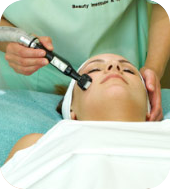As
we all know the color of the human skin is due to the presence of melanin. The
melanin is a pigment and its production cells is handled by the pigment cells
known as melanocytes.
When these cells are unable to produce melanin or are destroyed, it leads to formation of white spots (depigmentation) on the affected part of the skin. These white patches might be either small or big depending upon the severity of the skin problem. Treatment options are discussed below:
When these cells are unable to produce melanin or are destroyed, it leads to formation of white spots (depigmentation) on the affected part of the skin. These white patches might be either small or big depending upon the severity of the skin problem. Treatment options are discussed below:
Corticosteroid Creams
Application
of prescribed ointments on the affected part of the skin brings the desired
result, only when the treatment is taken on time. Topical therapy is effective
when the disease is in its early stages of development.
When
the white patches have just begun to form, applying these corticosteroid creams
or ointments like calcipotriene can definitely help to eliminate these white
spots and bring back natural color of the skin.
Once
the treatment has started, the patient will notice a considerable decrease in
the appearance of the white patches in 3 - 4 months time. This is considered to
be the best cure for vitiligo when the disease is treated in its initial
stages.
PUVA
PUVA
is a re-pigmentation treatment and involves getting rid of those white spots.
PUVA stands for psoralen ultraviolet A radiation. In this condition, the person
is first asked to take a medicine known as psoralen. A thin coat of psoralen is
applied on the affected part of the skin. The thin coating of psoralen is
allowed to remain there for a period of 30 minutes. It is then exposed to
ultraviolet A light.
Psoralen,
basically increases the sensitivity of the skin towards ultraviolet light.
Thus, affected skin with vitiligo, responds quite well when it is bombarded
with ultraviolet A waves. As the skin is very much sensitive to UVA light, the
light waves penetrate deep into the skin to correct the problem.
Bombarding
the skin with UVA light turns the affected part of the skin turns pink and
eventually normal skin color is achieved. 2-3 sessions are generally required
to restore natural appearance of the skin. PUVA is useful only when not more
than 20 percent of the skin is affected with vitiligo.
Oral Psoralen and Ultraviolet A Waves
In
case, more than 20% of the body is affected with these white spots, then
the strategy to treat vitiligo is slightly changed. In such cases, the patient
is advised to take psoralen pills or capsules before UVA exposure.
Depigmentation Therapy
When
the skin loses its natural color and turns light, the process is known as
depigmentation. In case, presence of vitiligo is observed in 50% of the body,
then PUVA treatments are not used.
On
the other hand, the normal skin that is not affected with vitiligo is treated
(depigmented) so that the color matches with the vitiligo affected skin. The
drug that is used to depigment the skin is known as monobenzenzyl ether of
hydroquinone.
The
medicine is applied two times daily on the unaffected part of the skin so as to
depigment it. This procedure is stopped when the normal areas of the skin
resemble the vitiligo affected skin.
Diet
A
person diagnosed with vitiligo should avoid meat (that includes fish). Doctor
advice their patients to eat vegetables like spinach broccoli, cabbage,
brussels sprouts and carrots. Also avoid spices and junk food as they could
irritate. When it comes to fruits, vitiligo patients should eat mangoes, peaches, apples and black dates. Drinking plenty of water is equally important
for the treatment of vitiligo.
Herbs
Use
of herbs such as St. John Wart can contribute immensely to minimize the
appearance of white spots. Rubbing St John wort alcohol tincture can be helpful
in this regard. One can also rub fresh juice of another herb known as lemna
(wild duck) on the white patches 4 -5 times daily to decrease their appearance.
Precautions
Along
with the aforementioned treatment options, one has to take certain precautions
to speed up healing. Exposure to sun for a person with vitiligo is not
recommended. The harmful UV rays will turn the skin darker.
This
in turn will make the white spots more prominent and noticeable. So applying a
sunscreen lotion (SPF more than 30) without fail, before going out in the sun
will keep these damaging effects of the UV rays at bay.
If
you are not comfortable with the aforementioned treatment options, you can
always take the help of special make ups to conceal these undesirable changes
in the skin. Remember, the key to get rid of this problem is to treat it as
early as possible.
The most
famous proponent of such as system is Michael Dawson, a certified nutritionist,
health consultant and independent medical research. Dawson is the author of
"Natural Vitiligo Treatment System™", a
step-by-step guide on how to cure vitiligo naturally and safely.





No comments:
Post a Comment